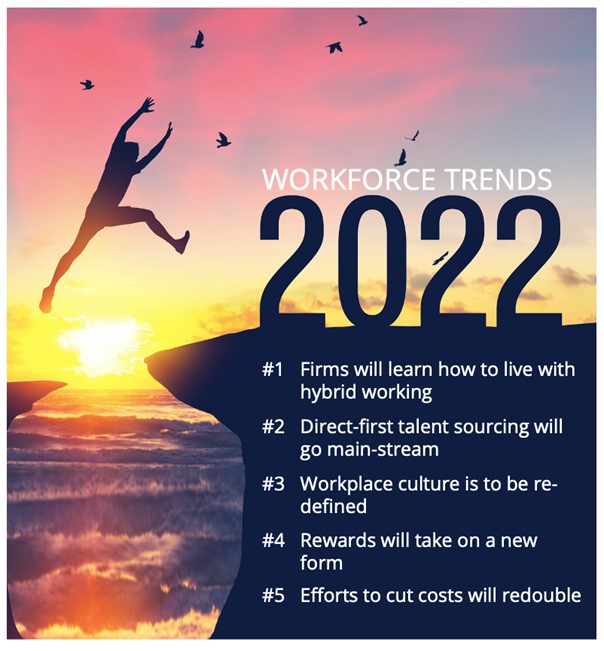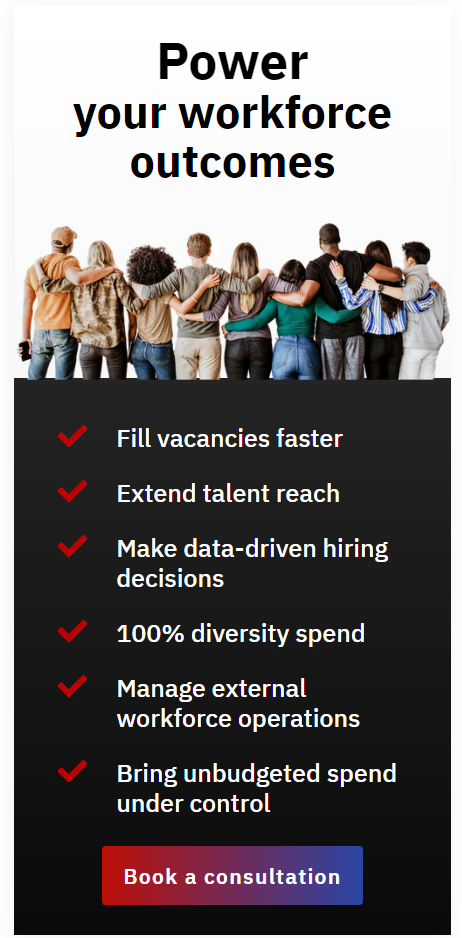Before examining 2022 trends, keep in mind that 2021 was no ordinary year for talent leaders
2021 was a murderous year for talent leaders. It began with the weird Orwellian virtual work-life of the lockdown period. Then, the mass return to work happened and seemingly every hiring manager started scouting for talent at the same time to fill gaps in their resourcing. Then, the panic of filling vacancies grew to a crescendo just as the Great Resignation began to hit home.
The figures around the Great Resignation are astonishing. The Department of Labor’s statistics showed that 4.5 million employees voluntarily left their jobs during November, and there was a 370,000 increase in resignations.
The start, stop, go home, go to work chaos of 2021 has left many talent leaders wondering what joys 2022 holds in store for them and their teams. In this article, we’ve brought together some predictions on what workforce trends to expect in 2022.

Our Top Five 2022 Workforce Trends
1. Firms will learn how to live with hybrid working
Once seen a curiosity, a once-in-a-lifetime event, the lockdown that resulted from governmental reactions to the COVID-19 pandemic led to a new way of life for many information workers. Hybrid working was born, providing greater flexibility over where people worked. The trend to go into the office two or three times a week and to spend the remainder at home became the norm.
And it seems, once workers got accustomed to this new arrangement, they decided they liked it. Suddenly, house prices in suburbs and coastal areas started to soar, as workers re-designed their lives around a new work reality. Demand for detached houses that offered additional floor space for home offices, hobby rooms, and side hustles. In 2021, business leaders tried hard to adapt their past policies and work pattern behaviors to fit the new work living arrangements. Many, forced their workers back to their desks with threats over reducing incomes if they didn’t. Others, embraced the new reality, suggesting that traditional workplaces would become the exception.
In 2022, we can expect the novelty of hybrid working to transform into the new reality. A reality that bosses will have to come to terms with and start strategizing for a new way of working. Bluntly, most workers don’t want to work in offices five days a week and the Great Resignation that has occurred over the past year means it’s a sellers’ market. Employers face the stark choice of going with the flow or living with the shortfall of talent. To accommodate hybrid working, talent leaders will need to think about incorporating more contingent workers into their workforce to accommodate shift patterns, peaks, troughs in activity, etc.
2. Direct-first talent sourcing will go mainstream
One workforce trend that will continue to grow in 2022 is the shift towards direct sourcing.
Direct sourcing occurs when a business uses its social media presence to recruit directly, often enriched by a digital job board and in-house applicant tracking system. With faster fill rates, pre-vetted candidates, and gains on savings from staffing agency costs, the arguments for direct sourcing are compelling.
Already, adoption levels of direct sourcing are high. Ardent’s 2020 Direct Sourcing Toolkit research study found that 70% of businesses cited direct sourcing and talent pool curation as a top priority, but resourcing pressures have delayed many deployments. With pressures on recruitment teams to fill vacancies this year, it’s highly likely direct sourcing will become the go-to option in 2022.
3. Workplace culture is to be redefined
Hybrid working hasn’t been good news for everyone.
Industrial, manufacturing, healthcare, semi-skilled, and manual workers have seen little change in their lifestyle, as the necessity to go to work pervades.
Those who benefited most were the people in their later years or those with carer obligations who needed to look after their child or parent. Of course, there were also those who were happy to cut their commute so they could spend more time on their hobby or side hustle. Remote workers also benefitted, as employers were happier to consider them for roles in the absence of local candidates.
It is the younger cohort of workers that have suffered most from the shift away from office working. They have missed out on the experiences gained from learning from peers. They have found themselves isolated at home, often working in bedrooms, sometimes shared with siblings, with many living with parents because they have yet to get on the property ladder.
These workforce patterns are placing pressure on organizations to care more about the wellbeing of their people. But that’s difficult to get right when many are working remotely.
No list of 2022 Workforce Trends would be complete without registering the impact of hybrid working. It is reshaping work cultures, and the balance between solidarity and sociability that once existed in offices is being tested. In 2022, we can expect to see a stream of new initiatives from employers to find ways to tackle the emotional consequences of hybrid working and to address the cultural impacts it fosters.
4. Rewards will take on a new form
A decade ago, a company car was seen as a perk. So too was a rail season ticket. For many, those benefits have little appeal in today’s flexible working world. Many would prefer bosses to provide access to local collaborative office spaces, and support services like child care and fitness classes. Education too is a hot topic. Companies like Amazon and McDonald’s are promoting their commitment to training, knowing it to be a highly desirable benefit of candidates.
Competition on rewards and benefits packages is set to grow this year and comes in at number four in our list of 2022 Workforce Trends. Expect firms to be ‘creative’ in their perks packages and lean in towards the wellbeing and personal career development areas that have become increasingly important to remote workers.
5. Efforts to cut costs will redouble
Saving money remains a key priority for executives. With salary costs going up, organizations want to see more compensating economies in the back office. As one procurement officer put it to me recently, ‘Pressures on costs mean that we need to double down on automating any task that can be automated.’
One way to save money is not to spend it. This is causing talent leaders to invest more time in market insights to make sure the offered rates get the balance right. If the rates are too high, organizations will pay over the odds for the talent they hire. Too little and vacancies remain unfilled, or the quality and experience of talent becomes sub-optimal (with consequential impacts on productivity and results downstream).
In 2022, expect to see a growing demand for talent insight platforms and services that paint a clear picture of the workforce landscape, rates, staffing vendor terms, and program performance metrics.


